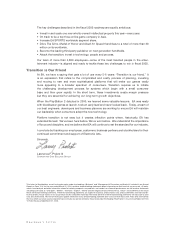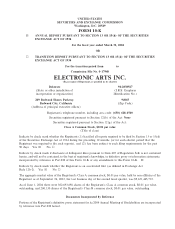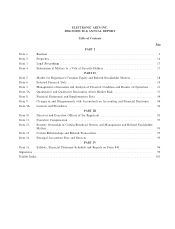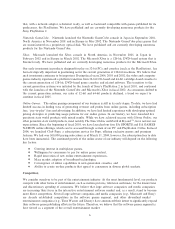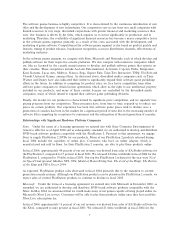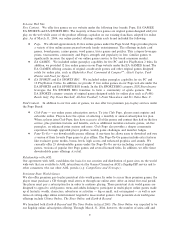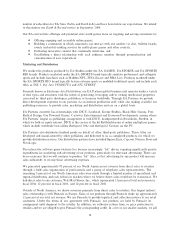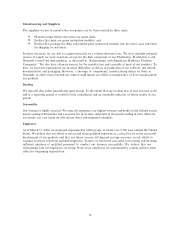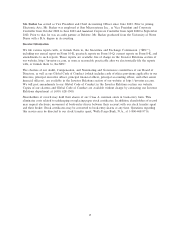Electronic Arts 2004 Annual Report Download - page 20
Download and view the complete annual report
Please find page 20 of the 2004 Electronic Arts annual report below. You can navigate through the pages in the report by either clicking on the pages listed below, or by using the keyword search tool below to find specific information within the annual report.
Intellectual Property
Like other entertainment companies, our business is based on the creation, acquisition, exploitation and
protection of intellectual property. Each of our products embodies a number of separately protected
intellectual properties: our products are copyrighted both as software and as audiovisual works; our product
names are trademarks of ours or others; and our products may contain voices and likenesses of third parties
or the musical compositions and performances of third parties. Our products may also contain other content
licensed from third parties, such as trademarks, Ñctional characters, storylines and software code.
We acquire intellectual property rights to include in our products through license agreements such as those
with sports leagues and player associations, movie studios and performing talent, music labels, music
publishers and musicians. These licenses are typically limited to use of the licensed rights in products for
speciÑc time periods. In addition, our products that play on videogame platforms such as the Sony
PlayStation 2 console include intellectual properties owned by the platform company and licensed non-
exclusively to us for use. While we may have renewal rights for some licenses, our business and the
justiÑcation for the development of many of our products is dependent on our ability to continue to obtain the
intellectual property rights from third parties at reasonable rates.
Our products are susceptible to unauthorized copying. Our primary protection against unauthorized use,
duplication and distribution of our products is copyright and trademark. We typically own the copyright to the
software code as well as the brand or title name trademark under which our products are marketed. We
register our copyrights in the United States, and register our signiÑcant trademarks in multiple countries
including the United States. In addition, console manufacturers such as Sony typically incorporate security
devices in their consoles in an eÅort to prevent unlicensed use of products.
Market
Historically, there have been multiple consoles available in our business segment and vigorous competition
between console manufacturers. While Sony has for the past several years been the clear leader (with its
PlayStation and PlayStation 2 consoles), Microsoft and Nintendo are large and viable competitors, and PCs
continue to be a strong interactive game platform. We develop and publish products for multiple platforms,
and this diversiÑcation continues to be a cornerstone of our strategy.
The following table details select information on a sample of the console platforms for which we have
published titles:
Video Game Console/ Date Introduced Medium/
Manufacturer Platform Name in North America Product Base Technology
Sega Genesis 1989 Cartridge 16-bit
Nintendo Super NES
TM
1991 Cartridge 16-bit
Matsushita 3DO
TM
Interactive Multiplayer
TM
1993 Compact Disk 32-bit
Sega Saturn 1995 Compact Disk 32-bit
Sony PlayStation 1995 Compact Disk 32-bit
Nintendo Nintendo 64 1996 Cartridge 64-bit
Sony PlayStation 2 2000 Digital Versatile Disk 128-bit
Nintendo Nintendo GameCube 2001 Proprietary Optical 128-bit
Format
Microsoft Xbox 2001 Digital Versatile Disk 128-bit
We currently develop or publish products for ten diÅerent hardware platforms. In Ñscal 2004, our product
releases were for PlayStation 2, Xbox, Nintendo GameCube, PlayStation, PC, Game Boy Advance, Nokia
N-Gage and online Internet play. Our planned product introductions for Ñscal 2005 are for the PlayStation 2,
Xbox, Nintendo GameCube, PlayStation, PC, Game Boy Advance, Nokia N-Gage, Sony PSP, Nintendo
Dual Screen and online Internet play.
PlayStation 2. Sony released the PlayStation 2 console in Japan in March 2000, in North America in
October 2000, and in Europe in November 2000. The PlayStation 2 console is a 128-bit, DVD-based system
5


